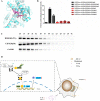A novel dammarane triterpenoid alleviates atherosclerosis by activating the LXRα pathway
- PMID: 37322486
- PMCID: PMC10273626
- DOI: 10.1186/s13020-023-00758-0
A novel dammarane triterpenoid alleviates atherosclerosis by activating the LXRα pathway
Abstract
Background: We have previously demonstrated that ginsenoside compound K can attenuate the formation of atherosclerotic lesions. Therefore, ginsenoside compound K has potential for atherosclerosis therapy. How to improve the druggability and enhance the antiatherosclerotic activity of ginsenoside compound K are the core problems in the prevention and treatment of atherosclerosis. CKN is a ginsenoside compound K derivative that was previously reported to have excellent antiatherosclerotic activity in vitro, and we have applied for international patents for it.
Methods: Male C57BL/6 ApoE-/- mice were fed a high-fat and high-choline diet to induce atherosclerosis and were subjected to in vivo studies. In vitro, the CCK-8 method was applied to evaluate cytotoxicity in macrophages. Foam cells were utilized, and cellular lipid determination was performed for in vitro studies. The area of atherosclerotic plaque and fatty infiltration of the liver were measured by image analysis. Serum lipid and liver function were determined by a seralyzer. Immunofluorescence and western blot analysis were conducted to explore the alterations in the expression levels of lipid efflux-related proteins. Molecular docking, reporter gene experiments and cellular thermal shift assays were used to verify the interaction between CKN and LXRα.
Results: After confirming the therapeutic effects of CKN, molecular docking, reporter gene experiments and cellular thermal shift assays were used to predict and investigate the antiatherosclerotic mechanisms of CKN. CKN exhibited the greatest potency, with a 60.9% and 48.1% reduction in en face atherosclerotic lesions on the thoracic aorta and brachiocephalic trunk, reduced plasma lipid levels and decreased foam cell levels in the vascular plaque content in HHD-fed ApoE-/- mice. Moreover, CKN in the present study may exert its antiatherosclerotic effects through activated ABCA1 by promoting LXRα nuclear translocation and reducing the adverse effects of LXRα activation.
Conclusions: Our results revealed that CKN prevented the formation of atherosclerosis in ApoE-/- mice by activating the LXRα pathway.
Keywords: ATP-binding cassette A1; Antiatherosclerosis; Derivative; Ginsenoside compound K; LXRα; Nuclear translocation.
© 2023. The Author(s).
Conflict of interest statement
The authors declare that they have no competing interests.
Figures






Similar articles
-
Leonurine Prevents Atherosclerosis Via Promoting the Expression of ABCA1 and ABCG1 in a Pparγ/Lxrα Signaling Pathway-Dependent Manner.Cell Physiol Biochem. 2017;43(4):1703-1717. doi: 10.1159/000484031. Epub 2017 Oct 18. Cell Physiol Biochem. 2017. PMID: 29045950
-
Homocysteine accelerates atherosclerosis via inhibiting LXRα-mediated ABCA1/ABCG1-dependent cholesterol efflux from macrophages.Life Sci. 2018 Dec 1;214:41-50. doi: 10.1016/j.lfs.2018.10.060. Epub 2018 Oct 28. Life Sci. 2018. PMID: 30393020
-
CKN reduces TLR4-mediated inflammation and cerebral I/R injury by activating the LXRα/ABCA1 pathway in microglia.Life Sci. 2025 Jun 1;370:123571. doi: 10.1016/j.lfs.2025.123571. Epub 2025 Mar 17. Life Sci. 2025. PMID: 40107493
-
Danthron attenuates experimental atherosclerosis by targeting foam cell formation.Exp Physiol. 2021 Mar;106(3):653-662. doi: 10.1113/EP089021. Epub 2021 Feb 2. Exp Physiol. 2021. PMID: 33450102
-
PLK1 promotes cholesterol efflux and alleviates atherosclerosis by up-regulating ABCA1 and ABCG1 expression via the AMPK/PPARγ/LXRα pathway.Biochim Biophys Acta Mol Cell Biol Lipids. 2022 Dec;1867(12):159221. doi: 10.1016/j.bbalip.2022.159221. Epub 2022 Aug 16. Biochim Biophys Acta Mol Cell Biol Lipids. 2022. PMID: 35981705
References
Grants and funding
LinkOut - more resources
Full Text Sources
Research Materials
Miscellaneous

